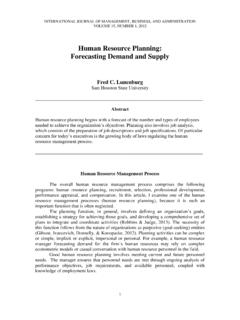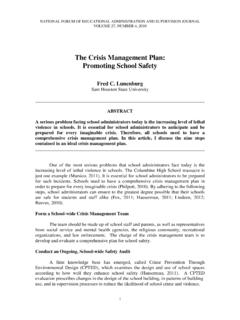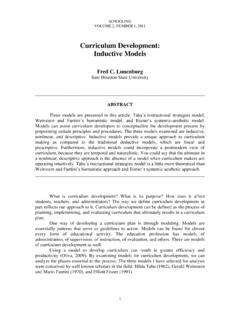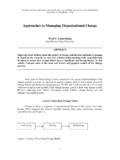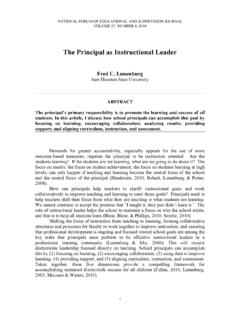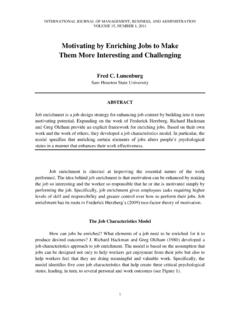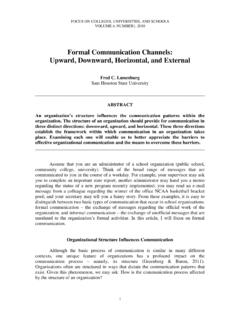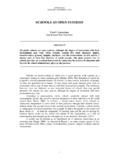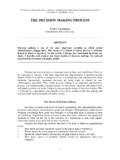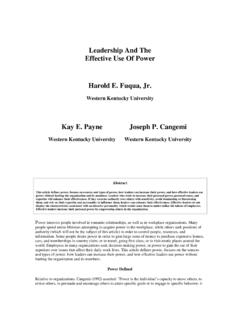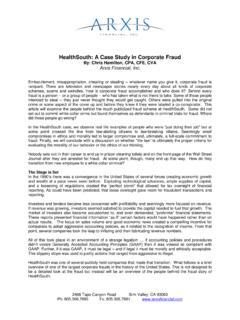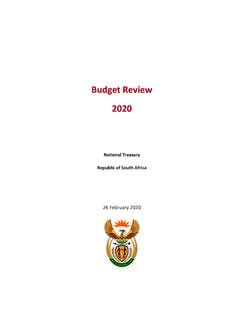Transcription of Understanding Organizational Culture: A Key Leadership Asset
1 NATIONAL FORUM OF EDUCATIONAL ADMINISTRATION AND SUPERVISION JOURNAL VOLUME 29, NUMBER 4, 2011 1 Understanding Organizational Culture: A Key Leadership Asset Fred C. Lunenburg Sam Houston State University _____ ABSTRACT Organizational culture is the set of shared beliefs, values, and norms that influence the way members think, feel, and behave. Culture is created by means of terminal and instrumental values, heroes, rites and rituals, and communication networks. The primary methods of maintaining Organizational culture is through the socialization process by which individuals learn the values, expected behaviors, and social knowledge necessary to assume their roles in the organization. Sometimes an organization determines that its culture needs to be changed. The change cycle includes the following components: external enabling conditions, internal permitting conditions, precipitating pressures, triggering events, cultural visioning, culture change strategy, culture change action plans, implementation of interventions, and reformulation of culture.
2 _____ How important is it for a leader to understand an organization s culture in order to bring about improved results? Every organization has a culture that can have a significant influence on the attitudes and behaviors of organization members. The competencies and values of employees and leaders play a key role in determining the effectiveness and success of an organization. In this article, I examine the concept of Organizational culture and how cultures are created, maintained, and changed. I begin with a brief overview of what Organizational culture is followed by four distinct culture phenotypes. What is Organizational Culture? The concept of Organizational culture was first noted as early as the Hawthorne studies (Mayo, 1933; Roethlisberger & Dickson, 1939), which described work group culture. It was not until the early 1980s, however, that the topic came into its own.
3 Several books on Organizational culture were published, including Terrence Deal and Allan Kennedy s corporate Cultures (1984), William Ouchi s Theory Z (1981), and Tom NATIONAL FORUM OF EDUCATIONAL ADMINISTRATION AND SUPERVISION JOURNAL 2_____ Peters and Robert Waterman s In Search of Excellence (1982). These books popularized Organizational culture, and researchers began in earnest to study the topic. Organizational theorists indicated that these cultures were real. They acknowledged that organizations have personalities just like people. For example, organizations can be flexible or rigid, supportive or unfriendly, innovative or conservative. Organization theorists documented the important role that culture plays in the lives of organization members. When you tell people where you work, they will ask you: What is it like there?
4 The description you give likely will have a lot to do with the organization s culture. In calculating your response to the question, you will describe the kinds of people who work at your school/school district. You will describe the work atmosphere on a typical day. You will describe the facilities in your work-place and how you feel people are treated. You will describe what it is that defines success at your school/school district. These responses give clues that help outsiders understand what your school/school district s culture is really like. To provide you with a more complete Understanding of Organizational culture, it is necessary to define the concept in more detail. Definition and Characteristics The culture of an organization is all the beliefs, feelings, behaviors, and symbols that are characteristic of an organization. More specifically, Organizational culture is defined as shared philosophies, ideologies, beliefs, feelings, assumptions, expectations, attitudes, norms, and values (Schein, 2011).
5 While there is considerable variation in the definitions of Organizational culture, it appears that most contain the following characteristics: Observed behavioral regularities. When organization members interact, they use common language, terminology, and rituals and ceremonies related to deference and demeanor. Norms. Standards of behavior evolve in work groups that are considered acceptable or typical for a group of people. The impact of work-group behavior, sanctioned by group norms, results in standards and yardsticks. Dominant values. An organization espouses and expects its members to share major values. Typical examples in schools are high performance levels of faculty and students, low absence and dropout rates of students, and high efficiency. Philosophy. Policies guide an organization s beliefs about how employees and clients are to be treated.
6 For example, most school districts have statements of philosophy or mission statements. Rules. Guidelines exist for getting along in the organization, or the ropes that a newcomer must learn in order to become an accepted member. FRED C. LUNENBURG _____3 Climate. This is an overall atmosphere that is conveyed in an organization by the physical layout and the way in which members interact with clients or other outsiders. None of these characteristics can by itself represent the essence of Organizational culture. However, the characteristics taken collectively reflect and give meaning to the concept of Organizational culture. Steinhoff and Owens (1989) have developed four distinctive culture phenotypes that demonstrate how these characteristics can be mixed to create highly diverse Organizational cultures likely to be found in public schools (see Table 1). Table 1 Four Distinctive Culture Phenotypes Family Culture This school can be described using metaphors such as family, home, or team.
7 The principal in this school can be described as a parent (strong or weak), nurturer, friend, sibling, or coach. In this school, concern for each other is important as well as having a commitment to students above and beyond the call of duty. Everyone should be willing to be a part of the family and pull their own weight. The school as family then is nurturing and friendly, often cooperative and protective. Machine Culture This school can be described using the metaphor of the machine. Metaphors for the school include well-oiled machines, political machines, beehives of activity, or rusty machines. Metaphors for the principal range from workaholic, Paul Bunyan, and The General to Charlie Brown and the slug. The school as machine then is viewed purely in instrumental terms. The driving force appears to come from the structure of the organization itself, and administrators are described in terms of their varying ability to provide maintenance inputs.
8 However, unlike those of the family culture, its mission is protection rather than warmth. Cabaret Culture Metaphors such as a circus, a Broadway show, a banquet, or a well-choreographed ballet performed by well-appreciated artists describe this school. The principal is seen as a master of ceremonies, a tightrope walker, and a ring master. Teachers in these schools experience many of the same group-binding social activities as do their colleagues in the family culture school. The essential difference is that, in this culture, relationships center on performances and the reactions of the audience. There is great pride in the artistic and intellectual quality of one s teaching, which is carried out under the watchful eye of the maestro. At the cabaret the show must go on! Little Shop of Horrors Culture This school can be described as an unpredictable, tension-filled nightmare having the characteristics of a war zone or revolution.
9 One never knows whose head will roll next. Teachers report their schools as closed boxes or prisons. The principal is a self-cleansing statue ready to offer up a sacrifice if it will maintain his position. Administrators in this school are seen as individuals whose main function is to keep things smoothed over. Others have a Napoleon complex that promotes dominance and control or Jekyll-Hyde personalities that promote a walking-on-eggs style of adaptive behavior among faculty. Unlike the family and cabaret cultures, teachers in this school lead isolated lives; there is little social activity. One is expected to conform and to smile when appropriate. Verbal abuse among faculty is common, and closeness seems to be melting away. This culture is cold, hostile, and paranoid. Almost anything can get you and it often does. _____ NATIONAL FORUM OF EDUCATIONAL ADMINISTRATION AND SUPERVISION JOURNAL 4_____ Creating Organizational Culture Deal and Kennedy (1984) identified four dimensions of Organizational culture: values, heroes, rites and rituals, and communication networks.
10 These four dimensions play a key role in creating Organizational cultures. Values What are values, and how do they affect behavior? Values are general criteria, standards, or principles that guide the behavior of organization members (Jones, 2010). There are two kinds of values: terminal and instrumental. A terminal value is a desired outcome that organization members seek to achieve. Schools typically adopt any of the following as terminal values: quality, excellence, and success (Bulach, Lunenburg, & Potter, 2012). An instrumental value is a desired mode of behavior. Modes of behavior that most schools advocate include working hard, providing excellent teaching, respecting student diversity, being creative, teamwork, and maintaining high standards (Lunenburg & Ornstein, 2012). Thus, an organization s culture consists of outcomes that the organization seeks to achieve (its terminal values) and the modes of behavior the organization encourages (its instrumental values).
